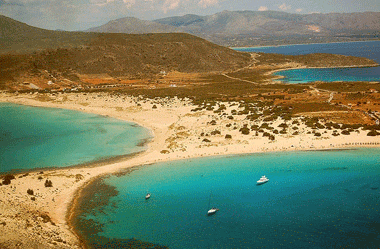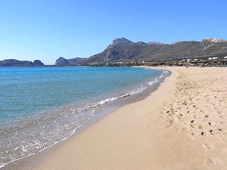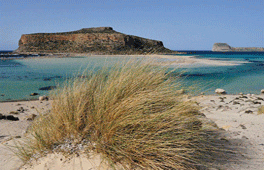CRETE
If you are looking for a great way to spend your vacation, then spend your holidays in Crete. Crete is an island with an exquisite 1,000 kilometer-long coastline dotted with numerous coves, bays and peninsulas, which afford a multitude of soft, sandy beaches along the beautifully blue Mediterranean Sea. After all, it's among the finest in the world and has established Crete as one of Europe's most popular holiday destinations. And, of course, the island's historic importance in today's world as the home of the Minoan civilization with important archeological finds at Knossos, Phaistos and Gortys, is evidenced by the tens of thousands of visitors to these sites each year.
 |
However, Crete is the largest island in Greece - the fifth largest in the Mediterranean - and, within its diverse area of more than 8,000 square kilometres, there are many other jewels just waiting to be discovered by the more adventurous explorers of holiday treasures.
Elafonisi beach
Elafonisi is one of the most rare and beautiful landscapes in all Europe : an extensive beach of unique beauty that overlooks the Libyan sea and an island that you can even walk to! The water is not higher than an adult's knee! Here, amongst the rare vegetation, we can find a kind of cedar tree and sand lilies that grow nowhere else in Europe . An area of about 2,000 acres of the seaside is protected by "NATURA 2000". All facilities are pretty much underdeveloped (parasols and small canteens), so it would be a good idea to bring along supplies (mostly water) which you can buy from the villages you will meet on your way (Elos and Vathi).
Only 5 km. from Elafonisi, by a small detour, you can visit the historical monastery of Hrisoskalitissa. The monastery is open for the public, and the hospitable monks will be glad to guide you through the grounds. Here you will also find fresh running water.
Falassarna beach
Falassarna is regarded as one of the nicest, natural beaches in Crete and one of the ten best beaches in Greece; it is located 16 km west of Kastelli and about 45 km west of Chania. The road leading to Falassarna village is quite good and during the first 35 km it is part of the National road of Crete.The Falassarna beach is a long, big, sandy beach with amazing views during the sunset. The sea is always very clear and it tempts you go for swimming.
 |
 |
Gramvousa
The peninsula of Gramvousa occupies the northwest of Crete and near its tip it has two islands, a good beach, an anchorage for small boats in bad weather, and the remains of a large Venetian castle. You may go to Gramvousa by organized boat trip from Kastelli or on foot. The boat trip is one hour long and the views of the rugged coastline are terrific. The hike, although not hard or long, can be very difficult during the summer months, when the sun and heat are strong. During the spring the area is blanketed in flowers.
Samaria
Samaria or the Samaria Gorge is one of the main sights of Crete. Every tourist who visits Crete will have heard of this beautiful gorge or soon will. The locals call it the “Farangas” or “Great Gorge”, both in admiration at its beauty and to differentiate it from the many other, smaller gorges of Crete.
The Samaria Gorge is in west Crete, in the White Mountains. It is the longest gorge in Europe, with a length of 18 kilometres.
The gorge starts at Xyloskalo (1227 m. above sea level) on the Omalos Plateau and runs down to the seaside village of Agia Roumeli on the south coast of Crete.
In Samaria you can admire the forests of huge pine and cypress trees, a picture from Crete’s past, when the island was covered by forests famous for their timber, ideal for building strong ships.
Inside the gorge you may even meet its famous inhabitants, the wild goats of Crete, which the locals call “agrimia” and tourists call “kri-kri”.
The Cretan wild goat is endemic to Crete and you will probably see some in the village of Samaria, as they often approach the houses at the edge of the village.
Lake of Agias
The lake is located in the southeast end of the municipality of Platanias , at its borders with the municipality of Nea Kydonia .
Although it is a man-made lake, it has been transformed into a living, unique biotope with a great variety of flora and fauna. For this reason, the lake and the territory that surrounds it, following the current of the river Keritis towards the sea, are protected by the "NATURA 2000" program of the European Union. The lake itself, as well as the route alongside the riverbank of Keritis, is a wonderful naturalistic experience and most characteristic of the area.
Aptera
It is located about 10 kilometers (6 miles) from Hania and 25 kilometers (15.5 miles) from Platanias, on the national road Hania-Rethimno. Ancient Aptera is built on an open plateau 200 meters above sea level, with an extraordinary view of the bay of Souda . Its history begins in the Minoan era (3500-1070 B.C.), but the most visible ruins are those of the Geometrical era (1000-685 B.C.), Hellenistic era (323-67 B.C.) and the Roman era.
Fortifications, aqueducts, public baths, burial grounds etc. are only some of the remains that can still be seen today. At the village Megala Horafia or Aptera, adjoining the archeological site, you will be able to find food, refreshments and water.